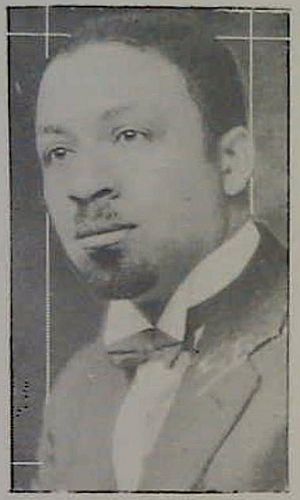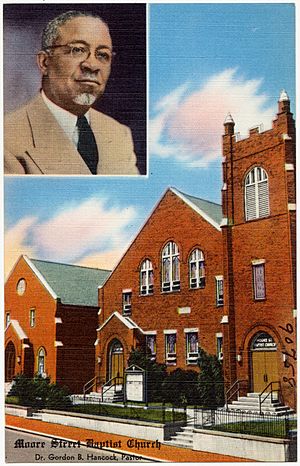Gordon B. Hancock facts for kids
Quick facts for kids
Gordon Blaine Hancock
|
|
|---|---|

Dr. Hancock in 1931
|
|
| Born | June 23, 1884 |
| Died | June 24, 1970 (aged 86) |
| Known for | Southern Conference on Race Relations, Double-duty dollar |
Gordon Blaine Hancock (June 23, 1884 – July 24, 1970) was an important leader for African American rights. He was a professor at Virginia Union University. Hancock spoke out for equality before the main Civil Rights Movement began.
He wrote newspaper columns that were published across the country. These articles appeared in 114 Black newspapers. Hancock helped organize the 1942 Southern Conference on Race Relations. This meeting led to a statement called the "Durham Manifesto." It clearly said that the group was against segregation and Jim Crow rules. Segregation meant keeping people of different races separate.
Hancock started teaching at Virginia Union University in 1921. He led the Economics and Sociology department. He also directed a special school there focused on race relations. Hancock believed that learning should lead to action. He made his students do community service. He also encouraged Black people to support businesses owned by Black people. He called this idea the "Double Duty Dollar."
Contents
Early Life and Family
Gordon Hancock was born on June 23, 1884, in Ninety Six, South Carolina. His parents, Robert and Anna Hancock, had been enslaved.
He went to college at Benedict College and Colgate University. He later earned a master's degree in sociology from Harvard University. Hancock was married to Florence Marie Dickson. He also served as the pastor of Moore Street Baptist Church in Richmond. He led the church from 1925 until he retired in 1963.
Fighting for Equality
Hancock was a strong voice for African American rights. He believed in standing up for what was right. In 1951, he wrote about the importance of supporting leaders like Dr. W.E.B. Du Bois. He felt that many influential Black people did not support Du Bois enough. Hancock believed that Du Bois was a symbol of strength and honesty for Black people.
Community Work
Hancock was very involved in his community. He became a member of the Omega Psi Phi fraternity while at Harvard.
He also helped start the Urban League of Greater Richmond. This group joined the National Urban League in 1923. The Urban League helps people achieve social and economic equality. They offer programs for jobs, healthcare, and education. Hancock served as pastor of Moore Street Baptist Church for almost 40 years. He retired from this role in 1963.
Teaching and Writing
Hancock was a clergyman, journalist, and educator. He worked hard to create more opportunities for Black people. In 1922, he started a course on race relations at Virginia Union University. This was one of the first courses of its kind in America.
As a professor, he taught students that the Black race was not less than white. He also taught that Black people were not more likely to commit crimes. He believed that better job opportunities could help break the cycle of poverty. Hancock taught that segregation was harmful and needed to end. He spoke at many colleges and universities.
In 1942, he helped organize the Southern Conference on Race Relations. This conference brought together Black leaders from across the South. They created the "Durham Manifesto." This document explained what Black people wanted after World War II. It covered political rights, jobs, education, and health.
Ideas for Change
Hancock created a plan called the "Double Duty Dollar." He encouraged Black people to keep their jobs, land, and money. He wanted them to spend their money within the African-American community. He thought that unemployment was a major problem for Black people. He also welcomed white people who supported education for African Americans.
Hancock's writings helped bring about changes. His article "Interracial Hypertension" led to reforms during World War II. It also helped create the "Durham Manifesto." He pushed for the Southern Regional Council to oppose segregation. This group worked to achieve equal opportunity through research and action.
Legacy
Hancock dedicated his life to educating Black people. He helped them build a stronger sense of identity. He taught his students that they were not inferior. His students said his work helped "progress race relations forward."
Hancock's "Double Duty Dollar" plan aimed to fight poverty. He also led campaigns to help Black people with unemployment. At his church, he helped clear a large debt. He also expanded the church's center for youth and community members. Hancock spent his life fighting segregation and social injustice. He used his lessons, sermons, and writings to inspire and educate Black people.


